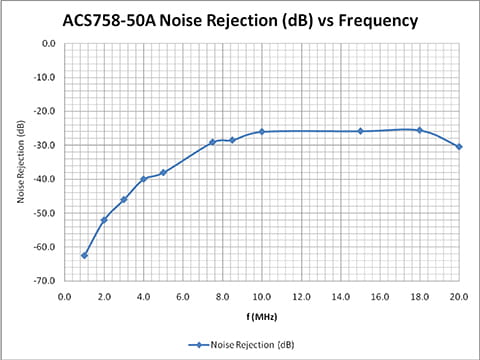
The current resolution of the ACS758 family of current sensor ICs is limited by the noise floor of the device output signal. For example, the ACS758-050 version can resolve a change in current level of about 250 mA, at 25°C, through its primary conductor leads. The 200 A version can resolve approximately 380 mA. At these levels, the amount of magnetic field coupled into the linear Hall-effect IC is just above its noise floor. Resolution can be improved significantly by filtering the output of the ACS758 for applications requiring lower bandwidth. Table 1 lists the noise levels, and hence current resolutions, at various bandwidths. Filtering was accomplished with a simple, first order RC filter. Note the related graphs, figures 2 through 5, which provide a better understanding of the device output resolution that can be achieved through filtering.
Table 1. ACS758 Noise Level and Current Resolution versus Bandwidth |
||||
|---|---|---|---|---|
| Device | Bandwidth -3 dB (kHz) |
Noise (mVp-p) |
Current Resolution | |
| (mA) | (% of full scale) | |||
| ACS758-200B | 120 | 3.84 | 384 | 0.192 |
| 10 | 0.92 | 92 | 0.046 | |
| 1 | 0.55 | 55 | 0.028 | |
| 0.2 | 0.15 | 15 | 0.008 | |
| ACS758-150B | 120 | 4.36 | 328 | 0.219 |
| 10 | 1.08 | 81 | 0.046 | |
| 1 | 0.52 | 39 | 0.026 | |
| 0.2 | 0.16 | 12 | 0.008 | |
| ACS758-100B | 120 | 5.69 | 285 | 0.285 |
| 10 | 1.49 | 75 | 0.075 | |
| 1 | 0.67 | 34 | 0.034 | |
| 0.2 | 0.22 | 11 | 0.011 | |
| ACS758-50B | 120 | 10.03 | 251 | 0.502 |
| 10 | 2.95 | 74 | 0.148 | |
| 1 | 1.05 | 26 | 0.053 | |
| 0.2 | 0.43 | 11 | 0.022 | |














Table 2. ACS758 Time to Valid Output |
||
|---|---|---|
| IP(A) | 0 | 50 |
| Power-On Time (µs) | 8 | 10 |


Table 3. Tested Maximum ACS758 Overcurrent Levels and Durations |
|
|---|---|
| Ambient Temperature (°C) |
Maximum Current (A) |
| 10 s, 10% duty cycle, 100 pulses applied | |
| 25 | 350 |
| 85 | 350 |
| 150 | 260 |
| 3 s, 3% duty cycle, 100 pulses applied | |
| 25 | 450 |
| 85 | 425 |
| 150 | 375 |
| 1 s, 1% duty cycle, 100 pulses applied | |
| 25 | 1200 |
| 85 | 900 |
| 150 | 600 |
Table 4. Typical Capacitive Coupling of a 20 V Peak-to-Peak Signal on the Current Path |
|||||||||||
|---|---|---|---|---|---|---|---|---|---|---|---|
| f (MHz) | 1.0 | 2.0 | 3.0 | 4.0 | 5.0 | 7.5 | 8.5 | 10.0 | 15.0 | 18.0 | 20.0 |
| VOUT(p-p)(mV) | 15.0 | 50.0 | 100.0 | 200.0 | 250.0 | 700.0 | 750.0 | 1000.0 | 1020.0 | 1050.0 | 600.0 |
| Noise Rejection (dB) | -62.5 | -52.0 | -46.0 | -40.0 | -38.1 | -29.1 | -28.5 | -26.0 | -25.8 | -25.6 | -30.5 |
